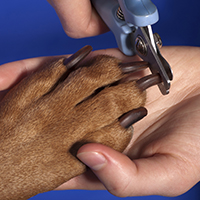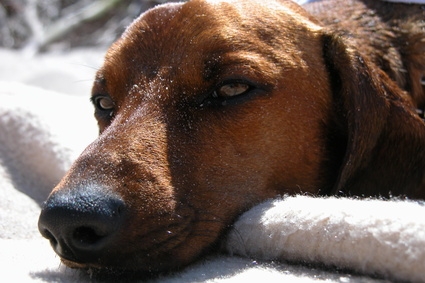Exercise is important for everyone including your pet. Too much confinement can result in stress, emotional and behavioral problems, and a generally unhappy dog.
Unhappy dogs result from negative environments, experiences, and inconsistent interaction with their owners, along with a lack of exercise, an unstable routine, inappropriate social interactions, and underemployment where the instinctual desires to perform an activity are not met.
Emotional stress and loneliness alter neurochemical and vascular functions and can increase susceptibility to major diseases.
A lack of exercise leads to obesity, poor muscle tone, heart, bone, and emotional problems.
The opposite scenario occurs with exercise. Exercise leads to longer life, increased strength and endurance. Your dog will rest more calmly and be less nervous when left alone. Exercise can improve the bone and joint health, heart, and lung function of your dog.
Your dog’s metabolism is geared for field work, pulling sleds, or other vigorous tasks. Pent-up energy demands an outlet and it is up to the responsible dog caregiver to channel this energy constructively through exercise.
The most effective exercise engages both mind and body.
It’s important to understand what your dog’s instinctual traits are and incorporate them into activities and exercise. For a working breed, performing a task would be naturally satisfying, possibly pulling a wagon or carrying a pack with your water bottle. For a retriever breed, engage your dog in ball throwing and retrieving.
Do not make the mistake of thinking that dogs need a big yard to get plenty of exercise.
The truth is that most dogs do not exercise when they are alone outside or indoors; they spend most of their time lying in a comfortable spot waiting for "their guardians" to play with them.
Exercising with your dog creates a human-dog bond in which the dog will sense you care as a good pack leader, which will make your dog happy.
A brief daily walk sometimes is not enough.
The exercise you choose for your dog should depend on the age, weight, health and breed characteristics. A Border Collie or Parson Russell Terrier needs more play and exercise than an English Bulldog or Pug.
For small dogs, vigorous play activity for exercise can be accomplished indoors; for larger breeds, outdoor activity needs to be given unless the weather is especially dangerous or conditions are too extreme.
Daily exercise is recommended and is a great stress reliever.
Dogs on average should be exercised aerobically for at least 20-30 minutes each day, of course taking into consideration health and age limitations, unless there is a medical problem or a pregnancy.
Keep in mind that obese dogs and those with heart and lung diseases may have a problem, and be sure to consult with your vet before starting any exercise regime.
Healthy dogs need interaction with other dogs and people for proper socialization. Dog parks are great for this and some of them allow the dogs to play and walk unleashed. If you participate in off-leash activities, be sure you are in control and can reliably recall your dog.
Your exercise should include activities the dog finds stimulating and enjoys -- games of catch, long walks, jogging, swimming and biking. A Ruff Dawg K9 flying disc is similar to a Frisbee, only more rugged, flexible and non-toxic for on-land or in water. Try a simple game with a rope tug toy, a Hyper Disc which is floatable, durable and soft on your dog’s mouth, or a Hyper Ball Launcher that allows you to launch a ball up to 220 feet. These and other quality dog exercise toys are available at CalloftheDogShop.com.
Caution should be used when exercising in the hot weather.
All dogs, especially those with heart and lung ailments and dogs with thick hair coats will likely have trouble with hot and humid conditions.
Use precaution when temperatures are approaching and greater than 100 degrees and for at-risk pets when approaching and at 90 degrees. Exercise your dog in the early morning or evening and when the temperature is less than 80 degrees and humidity heat index is less then 30 percent. When the heat index is greater then 72 use precaution for at-risk breeds. Any relative-humidity reading above 17% will make the heat index higher if the actual temperature is above approximately 68 degrees, and full sunshine can increase heat index values by up to 15 degrees. Always avoid hot and humid conditions.
Dogs do not get rid of heat the way we do.
Sweat cools our skin; however, dogs do not sweat. They have a few sweat glands in their feet, but mostly they dissipate heat through their paws and mouths.
Dogs do not dissipate heat as fast as we can, which makes heat stroke a real possible danger. While they are having fun, many dogs will run themselves even to the point of collapse, which can prove to be fatal. Limit sun exposure during the mid-day hours and provide plenty of water in a shady area.
People assume that if your dog is in water, your pet won't overheat. This just isn't true when the water temperature gets much above 75 degrees and if the dog is working hard in the water.
Keep in mind that searing hot asphalt is not good for your dog’s paws.
Consult your veterinarian before you decide on a fitness program for your pet.

 How to Make Your Own Paw Balm for Winter
To some dogs (especially breeds bui
How to Make Your Own Paw Balm for Winter
To some dogs (especially breeds bui
 Dog Odor Causes
Dog Odor Causes
Dog Odor Causes. As be
Dog Odor Causes
Dog Odor Causes
Dog Odor Causes. As be
 What Your 12-Week-old Puppy Needs
What Your 12-Week-old Puppy Needs
What Your 12-Week-old Puppy Needs
What Your 12-Week-old Puppy Needs
 What Is a Breeder?
Once again, I sit on the edge of th
What Is a Breeder?
Once again, I sit on the edge of th
 Shopping List for Your Puppy
Shopping List for Your Puppy
Shopping List for Your Puppy
Shopping List for Your Puppy